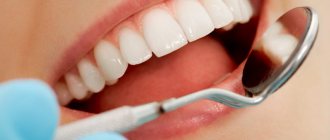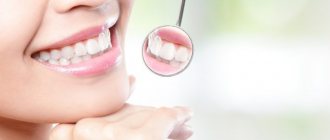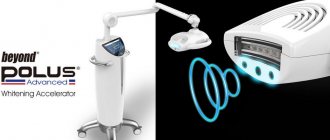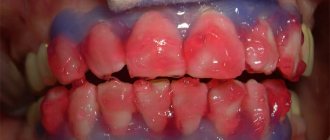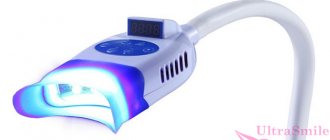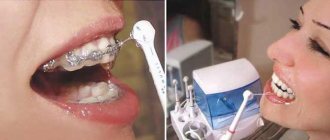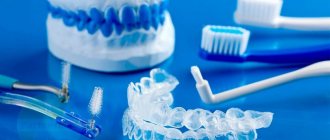Dentistry has come a long way in researching technologies to make your smile more attractive. Improving the appearance of teeth has long been considered a serious and important cosmetic procedure. There is a lot of information about what options and what you can choose from in this area. The reasons for tooth discoloration can be completely different. The foods we choose, medications taken during pregnancy or childhood, injuries, and medical interventions all play a role here.
To understand whether teeth whitening is the right choice for your situation, you need to understand the origins. And this can only be done through a thorough analysis of the clinical picture at an appointment with an experienced dentist.
Differences between Zoom 3 and previous technologies
Zoom and Zoom 2 are practically no different from previous photobleaching methods. So, for their implementation, gels with a certain amount of hydrogen peroxide were used. This technique was dangerous for tooth enamel, because the acid could wash away minerals , which led to gradual tooth decay.
Over time, a new technology, Zoom 3, appeared. When it was created, the shortcomings of previous whitening methods were taken into account, which made the new method truly comfortable and safe.
Features of Zoom 3:
- For bleaching, reagents and a lamp from the same manufacturer are used, which ensures their compatibility. Thus, the product contains components that can be activated only in the spectrum of a certain lamp.
- The bleaching machine has a minimal service life. It can only be extended by replacing the UV lamp, making the procedure completely safe.
- The Zoom 3 system is distinguished by the use of a gel that contains 25% hydrogen peroxide. This whitening regimen is truly gentle on tooth enamel.
- Zoom 3 is distinguished by the use of a special storage system. So, alkalizing components and hydrogen peroxide are in two different syringes. The ingredients are mixed during application to the enamel, which helps avoid its destruction.
- Before whitening and immediately after this procedure, teeth are treated with a special gel containing calcium phosphate. Thanks to this drug, the enamel structure is restored, and the teeth become less sensitive. This gel can be used at home to prevent caries.
What can patients expect from this method?
One of the main advantages of laser whitening is that from start to finish, the entire procedure takes about an hour before any difference is noticeable. Laser teeth whitening is not recommended for people who have bleeding gums, sensitive or other serious dental problems. Also, this procedure is not recommended for pregnant women and young people under the age of sixteen.
It is also possible that the patient's teeth will be whiter than expected. This is not a long-term problem due to the fact that laser whitening does not have permanent results. With this in mind, some spots may appear which may require additional laser treatments. This, of course, leads to further costs. However, the immediate results are worth the investment.
Advantages and disadvantages
The main advantage of Zoom 3 is its excellent aesthetic effect, which is confirmed by numerous reviews. Thus, almost all patients are satisfied with the results of whitening. Other advantages of the technology include:
- the ability to lighten enamel by 10-12 tones in an hour and a half, and the VITA scale is used to determine the required color;
- preservation of the result for 4-5 years, subject to proper oral care;
- to improve the result, the procedure can be repeated once every 6 months;
- the possibility of bleaching in the presence of various diseases, including fluorosis;
- the procedure helps to get rid of stubborn plaque caused by smoking, drinking wine and coffee;
- adjusting the intensity of laser exposure to teeth, making the method more gentle;
- the change in enamel shade is carried out evenly;
- absence of severe pain during the procedure due to the local influence of the beam;
- strengthening enamel and preventing caries.
The main disadvantage of the procedure is the need to sit under a lamp for a long time with your mouth open. In addition, some patients in reviews complain that whitening is quite painful. The occurrence of unpleasant sensations is explained by increased tooth sensitivity, which is observed in some patients. As a rule, the pain goes away no later than 2 days.
Other disadvantages of Zoom 3:
- During the procedure, some discomfort may occur, which is explained by heating of the tissues;
- the gel can have an aggressive effect on soft tissue if accidentally ingested;
- 1-2 days after the procedure, increased tooth sensitivity may be observed;
- in rare cases, an over-whitening effect occurs, that is, the shade of the teeth becomes unnaturally white.
In general, teeth whiteness lasts for 5 years, but some patients write in reviews that the effect is observed only for several months. This is due to individual characteristics and non-compliance with dental care rules.
Tips for teeth whitening
In the first 48 hours after the procedure, it is necessary to limit the consumption of foods with dyes (coffee, red wine, tobacco, red vegetables, colored sweets and sauces). Once the result is consolidated, there are no restrictions. The only factor influencing the condition of teeth and their color is hygiene.
Whitening your teeth without first brushing is a waste of time and money. After cleaning, the enamel takes on a natural appearance and the teeth become whiter. However, this has nothing to do with chemical discoloration of teeth.
Contraindications
Using Zoom 3 technology has a number of contraindications:
- presence of caries;
- a lot of fillings and prosthetic teeth, because in this case the result may be unsatisfactory;
- various gum diseases;
- enamel is too thin;
- increased sensitivity of teeth;
- allergy to the gel used for whitening;
- malignant tumors;
- period of chemotherapy;
- taking medications that increase skin sensitivity to light;
- pregnancy and breastfeeding;
- age less than 18 years.
Performing whitening
To lighten teeth, products containing 25% hydrogen peroxide are used.
After applying the gel, the teeth are irradiated with a UV lamp, which starts the chemical process. So, within 20 minutes, oxygen is actively produced and enters the tooth tissue. It destroys certain pigments, causing the enamel to lighten. Such gels can be used at home, but in this case, whitening will take a lot of time. Before the procedure, special preparation is carried out . First, the oral cavity is examined. So, if you have caries or serious damage to soft tissues, you will have to stop using the Zoom 3 technique. If there are no such problems, it is enough to have your teeth professionally cleaned.
The procedure itself lasts approximately 1-2 hours.
- First, the doctor uses a special VITA scale to determine the initial enamel grade and select a new color.
- For safety, before the procedure, a cream that protects from UV radiation is applied to the lips and cheeks. To prevent burns, the patient is given safety glasses. Then the lips are fixed with a retractor.
- A special composition is applied to the gums, which protects the soft tissues from the action of the gel.
- A thin layer of gel is applied to the smile area. Then a lamp mounted on a tripod is brought here. It only shines on the area being bleached. After 20 minutes, the remaining product is carefully removed and the gel is applied again. The procedure is repeated 2 more times.
- After bleaching is completed, the protective substance is carefully removed, and then a special solution is applied to the enamel to help restore it and reduce sensitivity.
Pros and cons of various techniques
Whitening with trays
A correctly installed mouthguard does not cause discomfort and over time ceases to be noticeable at all
Dental guards are a removable structure made of a special non-oxidizing material.
Typically, such caps are used to correct malocclusion or change the position of teeth.
A correctly installed mouthguard does not cause discomfort and over time ceases to be noticeable at all.
A suitable design is made on the basis of an impression made previously in the dentist's office, after which the finished mouthguard is filled with a whitening agent and installed on the teeth.
The advantages of this method:
- affordable price;
- Possibility of home whitening.
Minuses:
- weak brightening effect that is not able to
- act on yellow plaque;
- possibility of an allergic reaction;
- Mouth guards are contraindicated for patients wearing braces, as well as pregnant women and people who suffer from gum disease.
Laser technique
the effect is achieved through the action of a special gel on the tooth surface, which is activated by a laser beam directed at it
The most effective method among all modern methods of teeth whitening is laser.
If you follow all the doctor’s recommendations, the result will last for 10 years, and the shade will change in just one visit to the dentist.
The effect is achieved by applying a special gel to the tooth surface, which is activated by a laser beam directed at it.
As a result, the resulting oxygen ions penetrate the enamel and inactivate the ions of coloring substances.
The benefits include the following:
- in one procedure you can achieve a lightening effect of ten or more tones;
- absence of any discomfort or pain during the session;
- a trip to the dentist will not take much time, because the duration of exposure is no more than 20 minutes;
- the bactericidal properties of the gel have an antiseptic and anti-inflammatory effect on the oral cavity;
- The beneficial substances contained in the gel strengthen the enamel.
Still, there are some disadvantages:
- high cost of the service;
- Immediately after the session, high sensitivity of the teeth is observed.
Ultrasonic cleaning
Thanks to the mechanical action of the vibrating rod, the surface of the teeth is cleaned of all unwanted deposits
In this case, the enamel is lightened by removing the deposits that have formed.
Thanks to the mechanical action of the vibrating rod, the surface of the teeth is cleaned of all unwanted deposits.
At the final stage, the dentist applies a paste that improves the protective properties of the enamel and increases the teeth’s resistance to external irritants.
Professional ultrasonic cleaning effectively removes plaque from above the gums, and also cleans the cavity from stone located under the gums.
Advantages:
- in just one session, teeth are whitened by 1-2 shades;
- During the procedure, tartar is removed and the entire oral cavity is cleansed;
- absolute painlessness of the technique;
- affordable price of the procedure.
The disadvantages include:
- To maintain the result, you should repeat the cleaning session every year;
- the lightening effect of just a couple of tones may not be sufficient;
- surface exposure is unable to change the natural shade of dentin;
- The duration of the procedure is 1 hour.
Chemical bleaching
A highly concentrated preparation changes the shade of dentin, due to which teeth whiten by 5-10 tones
Lightening of enamel during chemical exposure occurs due to hydrogen peroxide or urea contained in the gel.
The highly concentrated preparation changes the shade of dentin, due to which teeth are whitened by 5-10 tones.
Pros:
- effective plaque removal and lightening of the natural shade of dentin;
- highly concentrated composition does not require
- additional processing with a special device.
The disadvantages include:
- high sensitivity of enamel after the session;
- expensive cost of the service;
- the short duration of the effect if the procedure was performed with errors.
Air Flow
Under the influence of a strong stream of air, water and soda, the most inaccessible places in the oral cavity are cleaned
Whitening using the Air Flow system has a mechanical effect only on the surface of the tooth, without affecting the dentin.
The dentist performs this abrasive cleaning using a special sandblasting machine.
Under the influence of a strong stream of air, water and soda, the most inaccessible places in the oral cavity are cleaned, plaque is effectively removed and the enamel is polished.
Advantages of the method:
- painlessness;
- the ability to thoroughly clean the entire oral cavity, down to the fissures and interdental crevices;
- the gentle effect on the enamel eliminates any damage to the teeth and gums;
- no increased sensitivity after the session;
- affordable price.
Flaws:
- weak whitening effect;
- a number of contraindications make this cleaning method inaccessible to some patients.
Photobleaching
Enamel lightening using Zoom technology occurs due to exposure to ultraviolet light
The technique includes various whitening options: Zoom of varying degrees, Beyond Polus and Luma-Arch.
Enamel lightening using Zoom technology occurs due to exposure to ultraviolet radiation.
The effect of the Beyond system is achieved through the use of blue spectrum light, and with Luma-Arch, specialists whiten the enamel using halogen radiation.
The advantages are:
- enamel whitening in one procedure by 10 tones;
- durability of the effect;
- no pain.
These techniques also have some disadvantages:
- none of the systems will be able to lighten hard-to-reach areas of the oral cavity;
- Only the front teeth are whitened;
- high price;
- Incorrect technique can cause serious burns to the mucous membranes or damage tooth enamel.
Endobleaching
Dentist fills cleaned tooth cavity with whitening agent
This intra-canal teeth whitening is used when there is darkening of the enamel due to depulpation.
The dentist fills the cleaned tooth cavity with a whitening agent, and then installs a temporary filling.
After two weeks, if the enamel has lightened to the desired shade, the composition is removed and further treatment of the dental cavity is carried out.
Pros:
- This method allows, if necessary, to lighten one or more teeth;
- The brightening composition acts from the inside, thereby maintaining the integrity of the enamel and achieving a more pronounced effect.
Minuses:
- the method is not suitable for whitening the entire dentition;
- The cost of the service depends on the number of teeth treated.
Home teeth whitening
A snow-white smile is the standard of beauty for everyone without exception. Therefore, it is not surprising that many people try in every way to give their teeth the desired whiteness and lighten the enamel on their own at home.
Among the most popular home whitening procedures are the following:
- Using special whitening pastes. These products contain solid abrasive substances that attack tooth enamel. Whitening paste will help remove surface plaque and lighten your teeth several shades.
- Lightening strips. In appearance they resemble an adhesive plaster: a transparent or white strip is attached to the outside of the front teeth. The whitening gel applied to one side of the strip contains two active ingredients - hydrogen peroxide and urea. In the humid environment of the oral cavity, the gel begins to oxidize, due to which the enamel is further cleansed of accumulated contaminants.
- Application of “folk” methods. On the Internet you can find many homemade recipes for teeth whitening based on soda, hydrogen peroxide or activated carbon.
The advantages of home whitening include:
- democratic value;
- ease of use.
There are many more disadvantages:
- weak whitening effect compared to a professional procedure;
- negatively affects enamel, irritates the oral cavity and causes tooth hypersensitivity;
- can cause an allergic reaction, and in some cases provokes poisoning of the body if the active substance is accidentally swallowed.
Rules for patients
To ensure that the resulting effect lasts as long as possible, and the procedure itself does not lead to unpleasant consequences, you need to follow simple recommendations .
- Before whitening, you need to undergo a thorough examination, cure caries and relieve inflammation. After this, the doctor must determine the degree of sensitivity of the teeth.
- After whitening, very careful oral care will be required. So, you need to consume coloring products as little as possible, use only professional pastes and rinse your mouth with antiseptics.
- If there are contraindications, bleaching should be avoided.
- During the week after the procedure, you should avoid hot and too cold foods.
Clinical trials
Home whitening is not a solution for absent-minded young ladies who always forget everything, and women who are not ready to go on a colorless diet and give up smoking. Also, this method is not suitable for girls who want to put their smile in order in one sitting: before a vacation, wedding or other important event. However, in the case of some people, home remedies for a number of individual reasons (neglected enamel condition, genetic factors, etc.) are simply powerless. Anyone who needs quick whitening should head straight to the dentist's office: in his chair you can change your smile beyond recognition in just a couple of hours.
Zoom or laser whitening
Patients who decide to lighten their teeth often doubt the choice of technique. They ask doctors, read reviews, but are still unsure. To avoid mistakes, you need to pay attention to several important criteria:
- Duration of the procedure. Teeth whitening using both systems lasts about an hour.
- Whitening effect. Thanks to two methods, it is possible to lighten the enamel by 10-12 tones.
- Saving the effect. After the Zoom 3 method, the whiteness lasts for about 5 years, and when using a laser, the smile will be snow-white for 7 years. Naturally, the time frame may be shorter if recommendations for oral care are not followed.
- Effect on tooth enamel. Zoom whitening may be unsafe if the technology is not followed. The laser technique is considered more gentle, since the dental tissues are not heated.
- Feel. During laser whitening, patients do not feel discomfort. After using Zoom technology, it is possible to increase sensitivity.
- Price. Laser whitening will cost much more than using the Zoom technique.
How to minimize harmful effects?
Unnatural whiteness of teeth is achieved due to exposure to active chemicals that affect the integrity of the enamel
A bright white smile attracts the attention of others and adds self-confidence, but is not a sign of dental health.
The thing is that dentin, which often has a yellow or grayish pigment, shines through the translucent layer of enamel.
Unnatural whiteness of teeth is achieved due to exposure to active chemicals that affect the integrity of the enamel, which subsequently affects the health of the oral cavity.
To minimize harm and possible risks, at the preparatory stage the specialist carries out a number of actions:
- Examines the patient's oral cavity and assesses the condition of the teeth.
- Based on the examination, all possible contraindications are identified, and the optimal and safest whitening method is selected.
- If necessary, the dentist uses a set of additional treatment and preventive measures to identify and eliminate pathological changes in the oral cavity.

